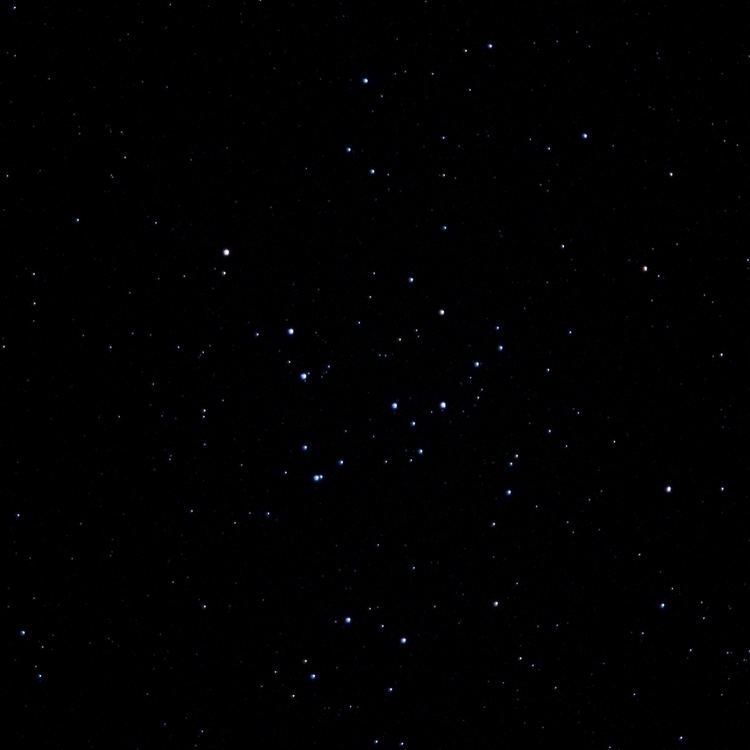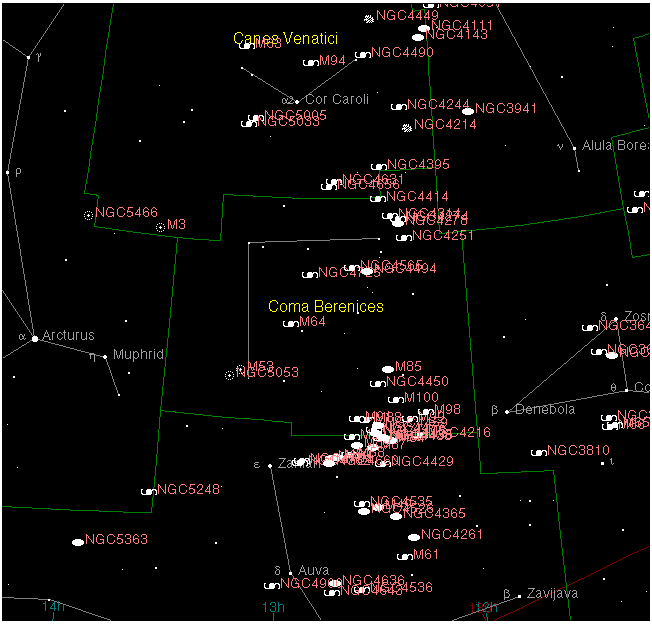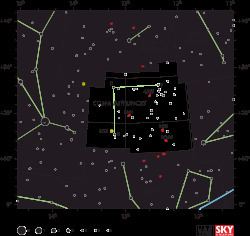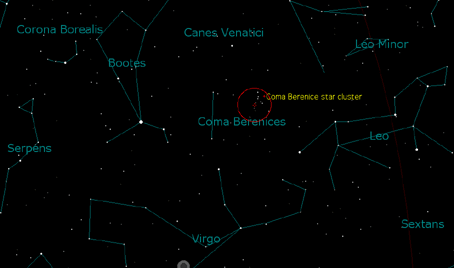Abbreviation Com Bayer/Flamsteed designation 44 Stars with planets 5 | Genitive Comae Berenices Main stars 3 Messier object 8 | |
 | ||
Pronunciation /ˈkoʊmə bɛrəˈnaɪsiːz/,genitive /ˈkoʊmiː/ Right ascension 11 58 25.0885–13 36 06.9433 Declination 33.3074303°–13.3040485° Similar Canes Venatici, Ursa Major, Boötes, Hydra, Hercules | ||
Coma berenices dwarf galaxy by moon
Coma Berenices is an ancient asterism in the northern sky which has been defined as one of the 88 modern constellations. It is located in the fourth galactic quadrant, between Leo and Bootes, and is visible in both hemispheres. It was introduced to Western astronomy during the third century BC by Conon of Samos. Its name means "Berenice's Hair" in Latin and refers to Queen Berenice II of Egypt, who sacrificed her long hair as a votive offering. Coma Berenices is the only modern constellation named for an historic figure. It was further corroborated as a constellation by Gerardus Mercator and Tycho Brahe.
Contents
- Coma berenices dwarf galaxy by moon
- Coma berenices
- History
- Non Western astronomy
- Features
- Brightest stars
- Star systems
- Variable stars
- Supernovae
- Other stars
- Coma Star Cluster
- Globular clusters
- Coma Supercluster
- Virgo Cluster
- Other galaxies
- Quasars
- Gamma ray bursts
- Exoplanets
- Meteor shower
- In culture
- References

Three of the constellation's stars are visible to the naked eye: Alpha Comae Berenices, Beta Comae Berenices and Gamma Comae Berenices. They form a 45-degree triangle, from which Berenice's imaginary tresses hang. The constellation's brightest star is Beta Comae Berenices, a 4.2-magnitude main sequence star similar to the Sun. Coma Berenices contains the North Galactic Pole and one of the richest known galaxy clusters, the Coma Cluster, part of the Coma Supercluster. Galaxy Malin 1, in the constellation, is the first known giant low-surface-brightness galaxy. Supernova SN 2005ap discovered in Coma Berenices is the brightest known, and SN 1940B was the first observed example of a type II supernova. The star FK Comae Berenices is the prototype of an eponymous class of variable stars. The constellation is the radiant of one meteor shower, Coma Berenicids, which has one of the fastest meteor speeds, up to 65 km/s (40 mps).

Coma berenices
History

Coma Berenices has been recognized as an asterism since the Hellenistic period (much earlier, according to some authors), and is the only modern constellation named for an historic figure. It was introduced to Western astronomy during the third century BC by Conon of Samos, the court astronomer of Egyptian ruler Ptolemy III Euergetes, to honour Ptolemy's consort, Berenice II. Berenice vowed to sacrifice her long hair as a votive offering if Ptolemy returned safely from battle during the Third Syrian War. Modern scholars are uncertain if Berenice made the sacrifice before or after Ptolemy's return; it was suggested that it happened after Ptolemy's return (around March–June or May 245 BC), when Conon presented the asterism jointly with scholar and poet Callimachus during a public evening ceremony. In Callimachus' poem, Aetia (composed around that time), Berenice dedicated her tresses "to all the gods". In the Latin translation of the poem by the Roman poet Catullus and in Hyginus' De astronomica, she dedicated her tresses to Aphrodite and placed them in the temple of Arsinoe II (identified after Berenice's death with Aphrodite) at Zephyrium. According to De astronomica, by the next morning the tresses had disappeared. Conon proposed that Aphrodite had placed the tresses in the sky as an acknowledgement of Berenice's sacrifice. Callimachus called the asterism plokamos Berenikēs or bostrukhon Berenikēs in Greek, translated into Latin as "Coma Berenices" by Catullus. Eratosthenes (3rd century BC) called it "Berenice's Hair" and "Ariadne's Hair", considering it part of the constellation Leo. The astronomer Geminus (1st century BC) recognized it as a distinct constellation. Astronomer Ptolemy (2nd century AD) considered it part of Leo, and called it "Plokamos".
Coma Berenices became popular during the 16th century. In 1515, a set of gores by Johannes Schöner labelled the asterism "Trica" (hair). In 1536 it appeared on a celestial globe by Caspar Vopel, who is credited with the asterism's designation as a constellation. That year, it also appeared on a celestial map by Petrus Apianus as "Crines Berenices". In 1551, Coma Berenices appeared on a celestial globe by Gerardus Mercator with five Latin and Greek names: Cincinnus, caesaries, πλόκαμος, Berenicis crinis and Trica. Mercator's reputation as a cartographer ensured the constellation's inclusion on Dutch sky globes beginning in 1589.

Tycho Brahe, also credited with Coma's designation as a constellation, included it in his 1602 star catalogue. Brahe recorded fourteen stars in the constellation; Johannes Hevelius increased its number to twenty-one, and John Flamsteed to forty-three. Coma Berenices also appeared in Johann Bayer's 1603 Uranometria, and a few other 17th-century celestial maps followed suit. Coma Berenices and the now-obsolete Antinous are considered the first post-Ptolemaic constellations depicted on a celestial globe. With Antinous, Coma Berenices exemplified a trend in astronomy in which globe- and map-makers continued to rely on the ancients for data. This trend ended at the turn of the 16th century with observations of the southern sky and the work of Tycho Brahe.
Before the 18th century Coma Berenices was known in English by several names, including "Berenice's Bush" and "Berenice's periwig". The earliest known English name, "Berenices haire", dates to 1601. By 1702 the constellation was known as Coma Berenices, and appears as such in the 1731 Universal Etymological English Dictionary.
Non-Western astronomy
Coma Berenices was known to the Akkadians as Ḫegala. In Babylonian astronomy a star, known as ḪÉ.GÁL-a-a (translated as "which is before it") or MÚL.ḪÉ.GÁL-a-a, is tentatively considered part of Coma Berenices. It was also argued that Coma Berenices appears in Egyptian Rameside star clocks as sb3w ꜥš3w, meaning "many stars".
In Arabic astronomy Coma Berenices was known as Al-Du'aba, Al Dafira and Al-Hulba, forming the tuft of the constellation Leo and including most of the Flamsteed-designated stars (particularly 12, 13, 14, 16, 17, 18 and 21 Comae Berenices). Ulugh Beg, however, regarded Al Dafira as consisting of two stars, 7 and 23 Comae Berenices.
In Chinese astronomy, the stars making up Coma Berenices were in two areas: the Supreme Palace enclosure and the Azure Dragon of the East. Eighteen of the constellation's stars were in an area known as Lang wei (seat of the general), part of the Supreme Palace enclosure, The Chinese gave proper names to several stars in the constellation.
The North American Pawnee people depicted Coma Berenices as ten faint stars on a tanned elk-skin star map dated to at least the 17th century. In the South American Kalina mythology, the constellation was known as ombatapo (face).
The constellation was recognized by several Polynesian peoples. The people of Tonga had four names for Coma Berenices: Fatana-lua, Fata-olunga, Fata-lalo and Kapakau-o-Tafahi. The Boorong people called the constellation "Tourt-chinboiong-gherra", and saw it as a small flock of birds drinking rainwater from a puddle in the crotch of a tree. The people of the Pukapuka atoll may have called it Te Yiku-o-te-kiole, although sometimes this name is associated with Ursa Major.
Features
Coma Berenices is entirely visible north of the 56th parallel south, and the constellation's midnight culmination occurs on 2 April. Although it is not large, Coma Berenices contains one galactic supercluster, two galactic clusters, one star cluster and eight Messier objects (including several globular clusters). These objects can be seen with minimal obscuration by dust because the constellation is not in the direction of the galactic plane. Because of that, there are few open clusters (except for the Coma Berenices Cluster, which dominates the northern part of the constellation), diffuse nebulae or planetary nebulae. Coma Berenices contains the North Galactic Pole at right ascension 12h 51m 25s and declination +27° 07′ 48″ (epoch J2000.0).
Brightest stars
Coma Berenices is not particularly bright, as none of its stars are brighter than fourth magnitude, but on clear, moonless nights up to fifty stars are visible to the naked eye. The constellation's brightest star is Beta Comae Berenices (43 Comae Berenices in Flamsteed designation, occasionally known as Al-Dafirah), at magnitude 4.2 and with a high proper motion. In Coma Berenices' northeastern region, it is 29.78 light-years from Earth. A solar analog, it is a yellow-hued F-type main-sequence star with a spectral class of F9.5V B. Beta Comae Berenices is slightly brighter than the Sun.
The second-brightest star in Coma Berenices is the 4.3-magnitude, bluish Alpha Comae Berenices (42 Comae Berenices), with the proper name Diadem, in the southeastern part of the constellation. Despite its Alpha Bayer designation, the star is dimmer than Beta Comae Berenices. It is a double star, with the spectral classes of F5V and F6V.
Gamma Comae Berenices (15 Comae Berenices), superimposed on the Coma Star Cluster, is an orange-hued giant star with a magnitude of 4.4 and a spectral class of K1III C. In the southwestern part of the constellation, it is 170 light-years from Earth and the brightest star in the Coma Star Cluster. With Alpha Comae Berenices and Beta Comae Berenices, Gamma Comae Berenices forms a 45-degree isosceles triangle from which Berenice's imaginary tresses hang.
Star systems
The star systems of Coma Berenices include binary, double and triple stars. 21 Comae Berenices (proper name Kissin) is a close binary with nearly-equal components and an orbital period of 26 years. The Coma Cluster contains at least eight spectroscopic binaries, and the constellation has seven eclipsing binaries: CC, DD, EK, RW, RZ, SS and UX Comae Berenices.
There are over thirty double stars in Coma Berenices, including 24 Comae Berenices with contrasting colors. Its primary is an orange-hued giant star with a magnitude of 5.0, 610 light-years from Earth, and its secondary is a blue-white-hued star with a magnitude of 6.6. Triple stars include 12 Comae Berenices, 17 Comae Berenices, KR Comae Berenices and Struve 1639.
Variable stars
Over 200 variable stars are known in Coma Berenices, although many are obscure. Alpha Comae Berenices is a possible Algol variable. FK Comae Berenices, which varies from magnitude 8.14 to 8.33 over a period of 2.4 days, is the prototype for the FK Comae Berenices class of variable stars and the star in which the "flip-flop phenomenon" was discovered. FS Comae Berenices is a semi-regular variable, a red giant with a period of about two months whose magnitude varies between 6.1 and 5.3. R Comae Berenices is a Mira variable with a maximum magnitude of almost 7. There are 123 RR Lyrae variables in the constellation, with many in the M53 galaxy. One of these stars, TU Comae Berenices, may have a binary system. The M100 galaxy contains about twenty Cepheid variables, which were observed by the Hubble Space Telescope. Coma Berenices also contains Alpha² Canum Venaticorum variables, such as 13 Comae Berenices and AI Comae Berenices.
Supernovae
A number of supernovae have been discovered in Coma Berenices. Four (SN 1940B, SN 1969H, SN 1987E and SN 1999gs) were in the NGC 4725 galaxy, and another four were discovered in the M99 galaxy (NGC 4254): SN 1967H, SN 1972Q, SN 1986I and SN 2014L. Five were discovered in the M100 galaxy (NGC 4321): SN 1901B, SN 1914A, SN 1959E, SN 1979C and SN 2006X. SN 1940B, discovered on 5 May 1940, was the first observed type II supernova. SN 2005ap, discovered on 3 March 2005, is the brightest known supernova to date with a peak absolute magnitude of about −22.7. Due to its great distance from Earth (4.7 billion light-years), it was not visible to the naked eye and was discovered telescopically. SN 1979C, discovered in 1979, retained its original X-ray brightness for 25 years despite fading in visible light.
Other stars
Coma Berenices also contains the neutron star RBS 1223 and the pulsar PSR B1237+25. RBS 1223 is a member of the Magnificent Seven, a group of young neutron stars. In 1975, the first extra-solar source of extreme ultraviolet, the white dwarf HZ 43, was discovered in Coma Berenices. In 1995, there was a very rare outburst of the WZ Sagittae-type dwarf nova AL Comae Berenices. A June 2003 outburst from GO Comae Berenices, an SU Ursae Majoris-type dwarf nova, was photometrically observed.
Coma Star Cluster
The Coma Star Cluster does not have a Messier or NGC designation, but is in the Melotte catalogue of open clusters (designated Melotte 111) and is also catalogued as Abell 1656. It is a large, diffuse open cluster of about 50 stars ranging between magnitudes five and ten, including several of Coma Berenices' stars which are visible to the naked eye. The cluster is spread over a huge region (more than five degrees across) near Gamma Comae Berenices. It has such a large apparent size because it is relatively close, only 288 light-years away.
Globular clusters
M53 (NGC 5024) is a globular cluster which was discovered independently by Johann Elert Bode in 1775 and Charles Messier in February 1777; William Herschel was the first to resolve it into stars. The magnitude-7.7 cluster is 56,000 light-years from Earth. Only 1° away is NGC 5053, a globular cluster with a sparser nucleus of stars. Its total luminosity is the equivalent of about 16,000 suns, one of the lowest luminosities of any globular cluster. It was discovered by William Herschel in 1784. NGC 4147 is a somewhat dimmer globular cluster, with a much-smaller apparent size.
Coma Supercluster
The Coma Supercluster contains the Coma and Leo Cluster of galaxies. The Coma Cluster, which forms Berenice's tresses, is 230 to 300 million light-years away. It is one of the largest known clusters, with at least 10,000 galaxies (mainly elliptical, with a few spiral galaxies). Due to its distance from Earth, most of the galaxies are visible only through large telescopes. Its brightest members are NGC 4889 and NGC 4874, both with a magnitude of 13; most others are magnitude 15 or dimmer. NGC 4889 is a giant elliptical galaxy with one of the largest known black holes (21 billion solar masses), and NGC 4921 is the cluster's brightest spiral galaxy. After observing the Coma Cluster, astronomer Fritz Zwicky first postulated the existence of dark matter during the 1930s. The massive galaxy Dragonfly 44 discovered in 2015 was found to consist almost entirely of dark matter. Its mass is very similar to that of the Milky Way, but it emits only 1% of the light emitted by the Milky Way.
Virgo Cluster
Coma Berenices contains the northern portion of the Virgo Cluster (also known as the Coma–Virgo Cluster), about 60 million light-years away. The portion includes five Messier galaxies. M85 (NGC 4382), considered elliptical or lenticular, is one of the cluster's brighter members at magnitude nine. M85 is interacting with the spiral galaxy NGC 4394 and the elliptical galaxy MCG-3-32-38. M88 (NGC 4501) is a multi-arm spiral galaxy seen at about 30° from edge-on. It has a highly-regular shape with well-developed, symmetrical arms. Among the first galaxies recognized as spiral, it has a supermassive black hole in its center. M91 (NGC 4548), a barred spiral galaxy with a bright, diffuse nucleus, is the faintest object in Messier's catalog at magnitude 10.2. M98 (NGC 4192), a bright, elongated spiral galaxy seen nearly edge-on, appears elliptical because of its unusual angle. The magnitude-10 galaxy has no redshift. M99 (NGC 4254) is a spiral galaxy seen face-on. Like M98 it is of magnitude-10 and has an unusually long arm on its west side. M100 (NGC 4321), a magnitude-nine spiral galaxy seen face-on, is one of the cluster's brightest. Photographs reveal a brilliant core, two prominent spiral arms, an array of secondary arms and several dust lanes.
Other galaxies
M64 (NGC 4826) is known as the Black Eye Galaxy because of the prominent dark dust lane in front of the galaxy's bright nucleus. Also known as the Sleeping Beauty and Evil Eye galaxy, it is about 24 million light-years away. Recent studies indicate that the interstellar gas in the galaxy's outer regions rotates in the opposite direction from that in the inner regions, leading astronomers to believe that at least one satellite galaxy collided with it less than a billion years ago. All other evidence of the smaller galaxy has been assimilated. At the interface between the clockwise- and counterclockwise-rotating regions are many new nebulae and young stars.
NGC 4314 is a face-on barred spiral galaxy at a distance of 40 million light-years. It is unique for its region of intense star formation, creating a ring around its nucleus which was discovered by the Hubble Space Telescope. The galaxy's prodigious star formation began five million years ago, in a region with a diameter of 1,000 light-years. The core's architecture is also unique because the galaxy has spiral arms which feed gas into the bar.
NGC 4414 is an unbarred spiral flocculent galaxy about 62 million light-years away. It is one of the closest flocculent spiral galaxies.
NGC 4565 is an edge-on spiral galaxy which appears superimposed on the Virgo Cluster. NGC 4565 has been nicknamed the Needle Galaxy because when seen in full, it appears as a narrow streak of light. Like many edge-on spiral galaxies, it has a prominent dust lane and a central bulge.
NGC 4651, about the size of the Milky Way, has tidal stellar streams gravitationally stripped from a smaller, satellite galaxy. It is about 62 million light-years away.
NGC 4676, sometimes called the Mice Galaxies, is a pair of interacting galaxies 300 million light-years from Earth. Its progenitor galaxies were spiral, and astronomers estimate that they had their closest approach about 160 million years ago. That approach triggered large regions of star formation in both galaxies, with long "tails" of dust, stars and gas. The two progenitor galaxies are predicted to interact significantly at least one more time before they merge into a larger, probably-elliptical galaxy.
Spiral galaxy Malin 1 discovered in 1986 is the first known giant low-surface-brightness galaxy. With UGC 1382, it is also one of the largest low-surface-brightness galaxies.
In 2006 a dwarf galaxy, also named Coma Berenices, was discovered in the constellation. The galaxy is a faint satellite of the Milky Way.
Quasars
HS 1216+5032 is a bright, gravitationally-lensed pair of quasars. W Comae Berenices (or ON 231), a blazar in the constellation's northwest, was originally designated a variable star and later found to be a BL Lacertae object. As of 2009, it had the most intense gamma ray spectrum of the sixty known gamma-ray blazars.
Gamma-ray bursts
Some gamma-ray bursts occurred in Coma Berenices, particularly GRB 050509B on 9 May 2005 and GRB 080607 on 7 June 2008. GRB 050509B, which lasted only 0.03 second, became the first short burst with a detected afterglow.
Exoplanets
Coma Berenices has seven known exoplanets. One, HD 108874 b, has Earth-like insolation.
Meteor shower
The Coma Berenicids meteor shower peaks around 18 January. Despite the shower's low intensity (averaging one or two meteors per hour) its meteors are some of the fastest, with speeds up to 65 km/s (40 mps).
In culture
Since Callimachus' poem, Coma Berenices has been occasionally mentioned outside astronomy. In 1886, Spanish artist Luis Ricardo Falero created a mezzotint print personifying Coma Berenices alongside Virgo and Leo. The constellation is also the subject of a 1892 short poem by Russian poet Afanasy Fet, composed for the Countess Natalya Sollogub. In 1999 Irish artist Alice Maher made a series of four oversize drawings, entitled Coma Berenices, of entwining black hair coils.
